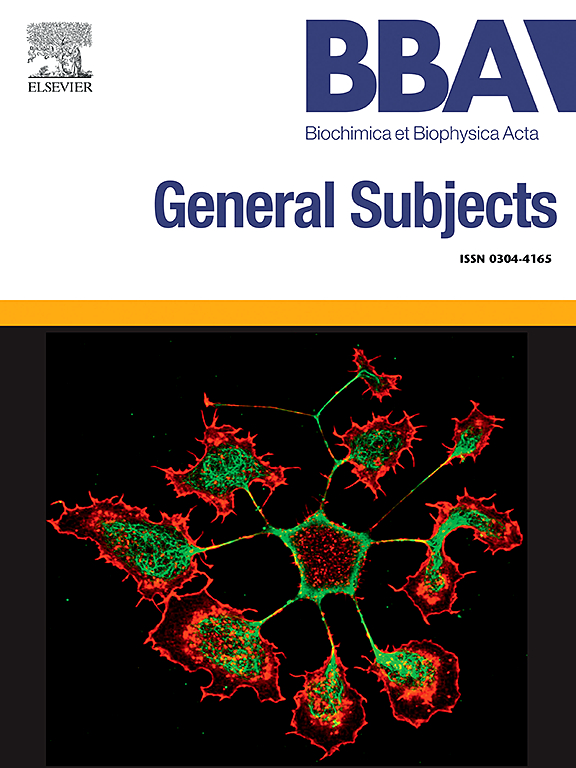MYO9B deficiency promoted head and neck tumor progression through HIF1α/MYC/STAT2 signaling pathway
IF 2.2
3区 生物学
Q3 BIOCHEMISTRY & MOLECULAR BIOLOGY
Biochimica et biophysica acta. General subjects
Pub Date : 2025-06-13
DOI:10.1016/j.bbagen.2025.130834
引用次数: 0
Abstract
Background
Myosin, a protein family primarily involved in muscle contraction and cell movement, plays critical roles in various biological processes. Increasing evidence suggests its implication in tumor development and progression. However, the underlying mechanism remains poorly understood. Our study aimed to explore the role and molecular mechanism of myosin IXB (MYO9B) in head and neck squamous cell carcinoma (HNSC) development.
Methods
Utilizing The Cancer Genome Atlas (TCGA) database (n = 24) and analyzing clinical HNSC tissues (n = 24), we investigated the correlation between myosin encoding genes and HNSC progression. Cell proliferation and migration were assessed using CCK8 and Transwell assays to elucidate the tumor suppressive role of MYO9B. Additionally, Western blotting and immunostaining were conducted to evaluate the activation of HIF1α/c-Myc/STAT2 signaling. A 3D Matrigel Primary tumor cell culture model was established to assess the cisplatin resistance of HNSC cells.
Results
We found that MYO9B deficiency predicted poor prognosis in HNSC patients. In vitro, inhibiting MYO9B enhanced the proliferative and migratory characteristics of HNSC cell lines. Mechanistically, our study showed that MYO9B deficiency upregulated HIF1α signaling, leading to c-Myc upregulation, which induced stem-like phenotypes in cancer cells and HNSC progression. Furthermore, c-Myc upregulated downstream STAT2 signaling, contributing to cisplatin resistance in HNSC cells. Blocking STAT2 signaling improved cisplatin outcomes in primary MYO9B-high HNSC tissues from patients.
Conclusion
Our study highlights the tumor suppressive role of MYO9B through HI1F1α/c-Myc/STAT2 in HNSC, suggesting its potential as a diagnostic indicator and therapeutic target for clinical intervention.
MYO9B缺乏通过HIF1α/MYC/STAT2信号通路促进头颈部肿瘤进展。
背景:肌球蛋白是一个主要参与肌肉收缩和细胞运动的蛋白家族,在各种生物过程中起着关键作用。越来越多的证据表明它与肿瘤的发生和发展有关。然而,其潜在的机制仍然知之甚少。本研究旨在探讨肌球蛋白IXB (MYO9B)在头颈部鳞状细胞癌(HNSC)发生发展中的作用及分子机制。方法:利用肿瘤基因组图谱(Cancer Genome Atlas, TCGA)数据库(n = 24),分析HNSC临床组织(n = 24),探讨肌球蛋白编码基因与HNSC进展的相关性。采用CCK8和Transwell检测细胞增殖和迁移,以阐明MYO9B的抑瘤作用。此外,通过Western blotting和免疫染色来评估HIF1α/c-Myc/STAT2信号的激活情况。建立三维Matrigel原代肿瘤细胞培养模型,评估HNSC细胞对顺铂的耐药性。结果:我们发现MYO9B缺乏预示HNSC患者预后不良。在体外,抑制MYO9B可增强HNSC细胞系的增殖和迁移特性。在机制上,我们的研究表明MYO9B缺乏上调HIF1α信号,导致c-Myc上调,从而诱导癌细胞的干细胞样表型和HNSC进展。此外,c-Myc上调下游STAT2信号,促进HNSC细胞的顺铂耐药。阻断STAT2信号可改善患者原发性myo9b高HNSC组织的顺铂治疗结果。结论:本研究突出了MYO9B通过HI1F1α/c-Myc/STAT2在HNSC中的抑瘤作用,提示其可能作为临床干预的诊断指标和治疗靶点。
本文章由计算机程序翻译,如有差异,请以英文原文为准。
求助全文
约1分钟内获得全文
求助全文
来源期刊

Biochimica et biophysica acta. General subjects
生物-生化与分子生物学
CiteScore
6.40
自引率
0.00%
发文量
139
审稿时长
30 days
期刊介绍:
BBA General Subjects accepts for submission either original, hypothesis-driven studies or reviews covering subjects in biochemistry and biophysics that are considered to have general interest for a wide audience. Manuscripts with interdisciplinary approaches are especially encouraged.
 求助内容:
求助内容: 应助结果提醒方式:
应助结果提醒方式:


